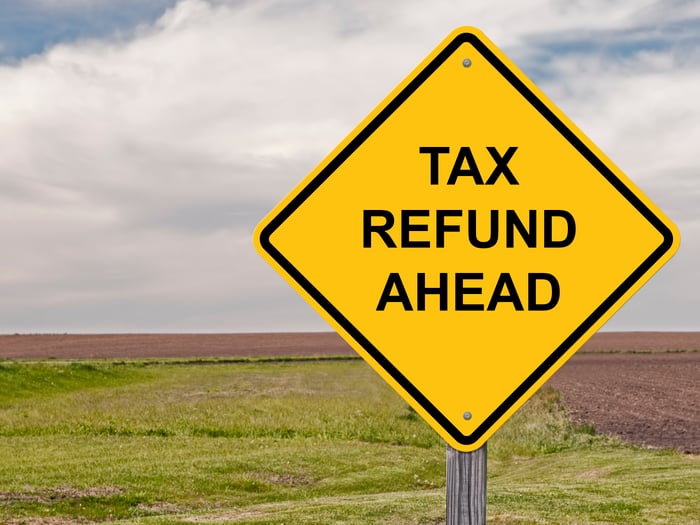Here we are in tax season again, with 1099 forms and other documents arriving in the mail. If you're an investor gearing up to prepare your tax return, know that there are some valuable tax breaks all investors should consider taking advantage of.
Here are three key tax breaks for investors that could lop thousands of dollars off tax bills. See which ones can benefit you this year or next.

Image source: Getty Images.
Make the most of retirement accounts such as IRAs and 401(k)s
Many major kinds of retirement accounts offer tax breaks. Consider, for example, the traditional IRA and the Roth IRA. With a traditional IRA, you contribute pre-tax money, reducing your taxable income for the year, and thereby reducing your taxes, too. (Taxable income of $75,000 and a $5,000 contribution? Your taxable income drops to $70,000 for the year.) The money grows in your account, and when you withdraw it in retirement, it's taxed at your ordinary income tax rate at the time -- which is often lower than your current rate.

Image source: Getty Images.
With a Roth IRA, you contribute post-tax money that doesn't reduce your taxable income at all in the contribution year. (Taxable income of $75,000 and a $5,000 contribution? Your taxable income remains $75,000 for the year.)
Here's why the Roth IRA is a big deal, though: Your money grows in the account until you withdraw it in retirement -- tax free. For 2016 and 2017, the IRA contribution limit is $5,500 -- plus $1,000 for those 50 or older.
Meanwhile, 401(k)s also come in traditional and Roth varieties, and their 2016 and 2017 contribution limits are far steeper -- $18,000 plus an additional $6,000 for those 50 and up. The table below shows how much you can accumulate by socking away various sums that grow at an annual average of 8%. Remember, if you do so within a Roth IRA and/or a Roth 401(k), the sums below may be yours tax free! If you're in a 25% tax bracket and empty a Roth account worth $500,000, you can avoid paying $125,000 in taxes!
|
Growing at 8% for |
$5,000 Invested Annually |
$10,000 Invested Annually |
$15,000 Invested Annually |
|---|---|---|---|
|
15 years |
$146,621 |
$293,243 |
$439,864 |
|
20 years |
$247,115 |
$494,229 |
$741,344 |
|
25 years |
$394,772 |
$789,544 |
$1.2 million |
|
30 years |
$611,729 |
$1.2 million |
$1.8 million |
Calculations by author.
Note, too, that you have until April 18 this year to make your IRA contribution for the 2016 tax year. (Just be sure to designate it as such.)

Image source: Getty Images.
Offset your taxable stock gains with your losses
Next, if you know you'll be facing taxes on capital gains you realized throughout the year, such as via stocks sold at a profit, you may be able to reduce or wipe out the taxes owed on that by offsetting the gains. If you have $6,000 in gains and you sell enough holdings to generate a loss of $5,000, you can pay taxes on only $1,000 in gains. If you have way more losses than gains, you can wipe out your gains entirely, then shrink your taxable income with up to $3,000 of your losses -- and then carry over any leftover losses into the next year.
Losses can sting, but they do offer a silver lining. (If you plan to buy back any of the losers you sold, be sure to wait at least 31 days, lest you end up with a "wash sale" that doesn't count.) It's too late to employ this tip for gains realized in the 2016 tax year, but keep it in mind for any gains you reap in 2017.

Image source: Getty Images.
Be smart about your investment holding periods
Finally, any time you find yourself considering selling some stocks, give a little thought to how long you've held them. Don't base your decision solely on taxes, but know that most of us face long-term capital gains tax rates (for qualifying assets that were held at least a year and a day) of 15%.
Short-term capital gains face your ordinary income tax rate, which could be close to twice as high. So if you've held a stock you want to sell for 11 months, consider hanging on for another month (and a day!). Note, too, that this tax break, like many others, may not always be in effect. Our representatives in Washington will occasionally change the tax rules we live by.
Clearly, though, there's a lot of money that can be saved if investors make some tax-savvy moves. Keep the above tips in mind -- and consider spending a little time learning about some more valuable tax breaks that can result in a bigger tax refund.




